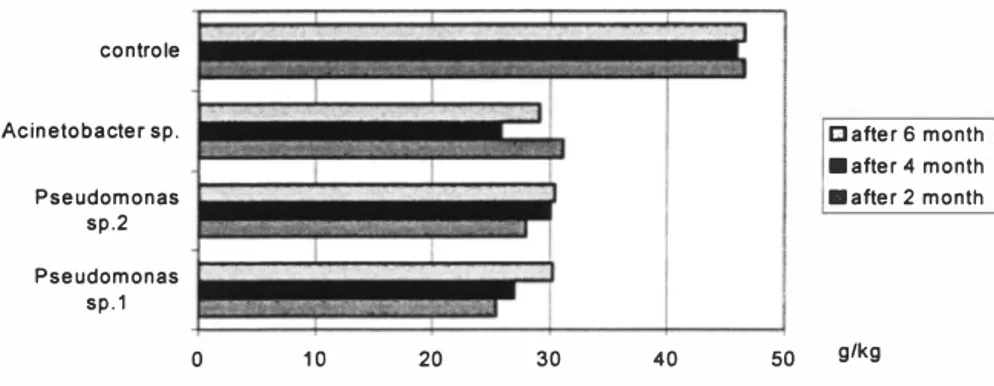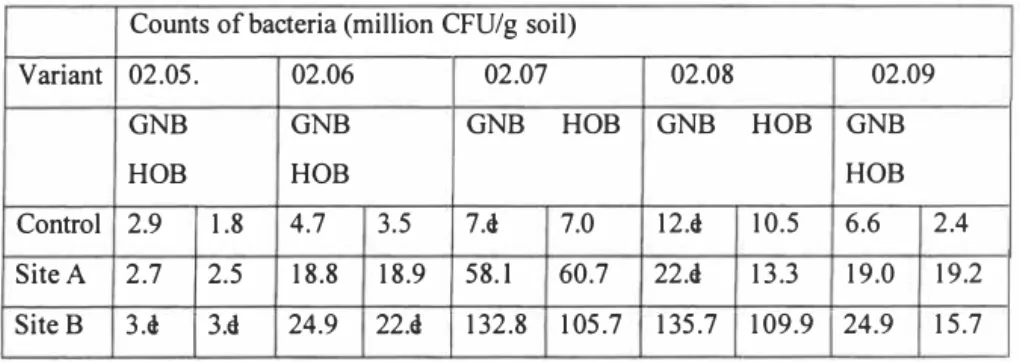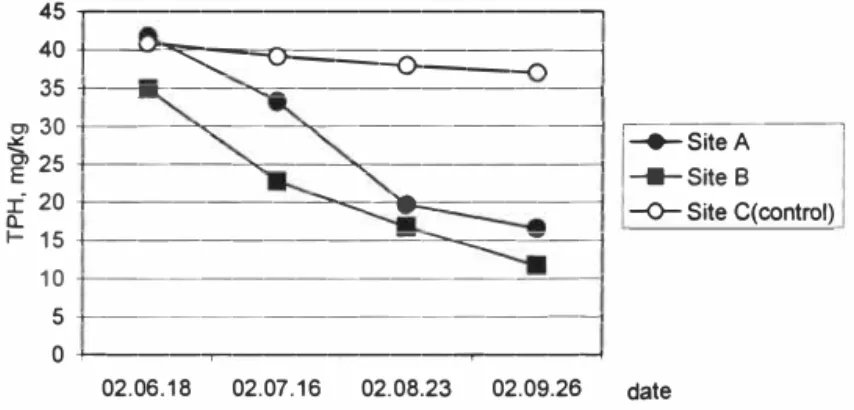KALMAR, SWEDEN, November 25-27, 2003
EFFECTIVENESS OF BIOREMEDIATION
PROCESS IN HYDROCARBON
-CONTAMINATED SOILS
Lilija Kalediene
Graiina Giedraityte
Vilnius University, Lithuania
Rapolas Liuiinas
Public Establishment "Soil Remediation Technologies", Lithuania
ABSTRACTThe present study was undertaken to evaluate the efficacy of introduced indigenous bacterial isolates for ex situ bioremediation of fuel oil contaminated soil. For this purpose three hydrocarbon-degrading indigenous bacterial isolates were screened from petroleum oil contaminated soil and repeatedly used for inoculation of fuel oil contaminated soil. The total petroleum hydrocarbons (TPH) content was determined by gravimetric method, Hydrocarbon fractions (alkanes, aromatics, asphaltenes and resins) present in TPH were obtained by silica gel column chromatography. The study showed that some introduced bacterial isolates effectively adapted to the contaminated soil. The bioaugmentation effect was calculated to raise the numbers of bacteria by approximately one order of magnitude from the indigenous population at the site. Ex situ study showed that the introduced bacterial consortium effectively adapted to the local environment of the soil at the bioremediation site.
Our results indicated that disappearance of TPH from inoculated soil samples depended on the general soil impurity, term of bacterial treatment, level of TPH contamination and individual microorganism efficacy. With application of bacterial consortium and fertilizers, the TPH level was reduced to 60 - 66% after three months.
KEYWORDS
Soil bioremediation, bacterial isolates, fuel oil hydrocarbons.
1 INTRODUCTION
Biodegradation is a natural process carried out by soil and aquatic microorganisms -mostly bacteria and fungi. Certain bacterial strains have demonstrated ability to break
KALMAR, SWEDEN, November 25-27, 2003
down or transform the chemical substrates present in petroleum products. The biodegradation of hydrocarbons by natural populations of microorganisms is one of the primary ways by which crude oil is eliminated from contaminated sites. Indeed, bacterial strains able to degrade many of the compounds present in oil are known to be ubiquitous in nature. For this reason, bioremediation has been considered a potentially useful tool in the cleaning of oil spills and the treatment of oil residues. The applicability of bioremediation depends upon the site characteristics, the nature of the pollutants, and the metabolic capabilities of microorganisms. Nevertheless, the presence of hydrocarbon degrading strains in sites contaminated with oil, or oil residues does not guarantee that oil components will be metabolized.
Biodegradation of petroleum hydrocarbons in soil can be limited by many factors, including nutrient availability (usually N), bioavailability of pollutant, bacterial biomass (both total and hydrocarbon degraders) and toxicity of the pollutant on microorganisms degrading the pollutants [l]. The evaluation of pollutant biodegradation is especially complicated, since the distribution of pollutants in the environment typically is patchy; therefore, a high number of replicate samples must be obtained for results to be statistically valid.
Microbiological processes can reduce hydrocarbons concentrations in soil to level that no longer pose an unacceptable risk to the environment or to human health.
From an environmental perspective, bacteria, which grow on hydrocarbons and mineralize them, may be especially useful for soil bioremediation. Many microbial strains, each capable of degrading a specific petroleum compound, are available commercially for soil bioremediation [2]. The reintroduction after enrichment of indigenous microorganisms isolated from a contaminated site helps to overcome this problem [3, 4]. The selected indigenous bacterial consortium has been shown to assist in bioremediation (bioaugmentation) and has an advantage of being resistant to variations in natural environment.
The aim of this study was to evaluate the efficacy of introduced bacterial isolates for bioremediation of fuel oil contaminated soil for purpose to screen the active microorganisms for the biopreparate creation.
2 LABORATORY STUDIES 2.1 Bacterial inoculum preparation
The aim of present investigation was to evaluate the efficacy of introduced bacterial isolates to stimulate the bioremediation of fuel oil contaminated soil where the indigenous population of hydrocarbon-degrading bacteria was low. It was reported that when the population of indi�enous microorganisms capable of degrading the target contaminant is less than 10 cells/g of soil, bioremediation would not occur at a significant rate [3, 4).
The initial population of bacteria in samples of fuel oil contaminated soil was found to be 103 cells/ g of soil. This suggested that a bacterial consortium might to be added.
KALMAR, SWEDEN, November 25-27, 2003
Some bacterial isolates that could degrade fuel oil were developed in minimal salt medium containing (g/1): NJ--LiNO3 - 1.0, MgCh - 0.1, KH2PO4 -3.0, K2HPO4 - 7.0, CaCO3 -1.0 with oily sludge from the samples of fuel oil contaminated soil. The soil
samples were collected from Kgkenai soil decontamination enterprise (Klaipeda region). Three indigenous bacterial isolates were selected for the present study. Bacterial isolates were screened on minimal salt medium, using oily-sludge as the sole carbon and energy source. Isolates were characterized by standard morphological, physiological and biochemical techniques and preliminary two isolates were identified as Pseudomonas sp., one strain as Acinetobacter sp. [5].
To prepare inoculums, bacterial isolates were grown separately in 2-liter Erlenmeyer flasks containing 500 ml of the minimal medium and sucrose (2%) as the sole carbon and energy source. All the isolates were grown to mid-log phase ( I 08 CFU/ml) and then mixed in equal proportions. After growth, the culture was immobilized onto the selected carrier materials, meal or wheat bran, by simple mixing in a I :3 ratio of carrier material culture. A total bacterial count of I 01° CFU/ml carrier material with moisture level of 70% was maintained.
2.2 Biodegradation assay
The TPH content was determined by gravimetric method. IO g of soil was four times extracted with 50 ml CH3Cl. The residual TPH obtained after Soxhlet extraction was dried over 20g of Na2 SO4 and concentrated by evaporation at 60e° C to constant weight.
Hydrocarbon fractions present in TPH were obtained by silica gel column chromatography following the technique described elsewhere [6]. After four successive elusions of I 00 mg fuel oil with I 00 ml hexane, I 00 ml benzene, I 00 ml chloroform and I 00 ml mixture of chloroform and ethanol (I: I), four fractions (alkanes, aromatics, asphaltenes and resins) were obtained. Each assay was performed in triplicate.
In order to evaluated the hydrocarbon biodegradation, the bottles containing 500 g of unsteriled fuel oil contamined soil were inoculated with the separate pure bacterial inoculum (I%) and with bacterial population consortium (I%), where each isolate made the equal part of inoculum, and grown at room temperature (14 - 18e° C). The each
1010
bacterial inoculum has cells/ 1ml physiological solution. Bottles containing non inoculated, unsteriled soil were used as control. Triplicate cultures and controls were sampled after I, 2, 4 and 6 month of growth to analyze degradation.
The level of TPH contamination in soil samples at different time periods during the course of the study under laboratory conditions are shown in figure I.
KALMAR, SWEDEN, November 25-27, 2003
controle
Acinetobacter sp. CJ after 6 month
■after 4 month
Pseudomonas ■after 2 month
sp.2
Pseudomonas sp.1
0 10 20 30 40 50 g/kg
Figure 1. The level of total petroleum hydrocarbons (TPH) in fuel oil contaminated soil (glkg) during 6 months by the addition of pure bacterial isolates.
The concentration ofTPH in contaminated soil samples was 47 to 49 g/kg. As shown in figure 1 the TPH degradation in soil samples inoculated with pure bacterial culture was quite fast during the first two month of incubation, except for control. The removal of various fractions ofTPH by bacteria mixture is shown infigure 2 and 3.
■
soil/bacterial"'
resins consortiumC:
.g
0 asphaltene□
controle (I)C: arom atics
0 alkane
total TPH
0 JO 20 30 40 50 g/kg
Figure 2. The removal of various fractions of total petroleum hydrocarbon (TPH) in strong contaminated soil (46.44 glkg- control (I)) within 6 months by the addition of
KALMAR, SWEDEN, November 25-27, 2003
■
soil/bacterialC: resins
.s
conesortium.,
asphaltene Im controle (II)0 C: aromeatics
.,
alkane 0 total TPH ,.:'.,., g/kg 0 10 20 30Figure 3. The removal of various.fractions of total petroleum hydrocarbons (TPH) in medium contaminated soil (25.18 g/kg- control (II)) within 6 months by the addition of
artificially mixed bacterial consortium.
As shown in.figures 2, 3 biodegradation processes in less polluted soil (25.18 g/kg) were 1.6 times faster during first month of incubation than in more polluted soil. In soil samples where concentration of TPH was 46.77 g/kg, a total of 55.7% of alkane, 37.5% of aromatic, 46.3% of asphaltene fractions were removed within first month. However, a total of resins in soil were higher and increased from 7.lg/kg to I l.07g/kg soil. The increase formed more than 54%. It seems that substrate-dependent causes (low water solubility, slow diffusion, adsorption, inhomogeneous pollutant distribution) are mainly responsible for pollutant adsorption on the soil and their biodegradability, because hydrocarbons can bind strongly to humic and other soil substances. In the soil samples where TPH concentration in control was 25.18 g/kg (see Figure 3) the removal ofalkane, aromatic fractions were higher then in the soil with TPH 47 g/kg. A total of 44.8% of alkane, 83.3% of aromatic, 50.6% of asphaltene fractions were removed. But the content of resins after one month increased and was 3.8 times higher than in control. This might be, because microorganisms heavily degrade the asphaltene and resins and consequently they are known as high molecular weight hydrocarbons.
3 FIELD STUDIES
A full-scale bioaugmentation study on fuel oil contaminated soil was conducted (from June to September) at Kiskenai soil decontamination enterprise (Klaipeda region) in 2002 year. Three sites with different contamination level were selected. The aim of the present investigation was to evaluate inoculum addition to stimulate ex situ bioremediation of fuel oil contaminated soil where the indigenous population of hydrocarbon-degrading bacteria was low. The contamination level of TPH in soil of site A, at the beginning of study, was found to be 41.819 g/kg, in site B - 34.910 g/kg, in site C (control)- 40.886 g/kg. The initial indigenous population of oily-sludge-degrading bacteria numbered 106 colony-forming units for 1 g of soil (CFU/g of soil) before addition of the bacterial
KALMAR, SWEDEN, November 25-27, 2003
consortium to the contaminated soil. In this experiment, the bacterial consortium was added in the form of carrier-based inoculum. Sites A, B were treated with the bacterial consortium and N, P, K fertilizers (700mg/kg soil). One kilogram of carrier-based bacterial consortium and 50 I of a nutrient mixture (NaCl - 20g, MgSO4x7H2O -25g, K2HP- 50g, KH2PO4 - 25g, �Cl - 25g) were added to all the sites except control. The soil was thoroughly tilled at 7 days intervals.
Ex situ study showed that the introduced bacterial consortium effectively adapted to the local environment of the soil at the bioremediation site (see Table 1).
Table 1. Proportion of the general number of bacteria (GNB) and numbers of hydrocarbon oxidizing bacteria (HOB) in fuel oil contaminated sites. Counts of bacteria (million CFU/g soil)
02.07 02.08 02.09
Variant 02.05. 02.06
GNB HOB GNB HOB GNB
GNB GNB
HOB HOB HOB
Control 2.9 1.8 4.7 3.5 7.e1 7.0 12.e1 10.5 6.6 2.4
Site A 2.7 2.5 18.8 18.9 58. l 60.7 22.el 13.3 19.0 19.2
Site B 3.e1 3.e1 24.9 22.el 132.8 105.7 135.7 109.9 24.9 15.7 The bioaugmentation effect was calculated to raise the numbers of bacteria by approximately one order of magnitude from the indigenous population at the site. The contamination level of TPH in soil of Site A was found to be 4 1.819 g/kg. With application of bacterial consortium and fertilizers, the TPH level was reduced to 16.619 g/kg. Accordingly, in B site from 34.910 g/kg to 1 1.702 g/kg. It revealed biodegradation of 60 - 66% after three months (see Figure 4).
These data demonstrated one of the important benefits of biostimulation (bioaugmentation) - addition of nutrients and introduced microorganism to stimulate the indigenous microbial population - as a remediation strategy [7]. Rapid removal of fuel oil from oily-sludge contaminated soil was achieved using carrier-based bacteria and N, P, K fertilizers.
KALMAR, SWEDEN, November 25-27, 2003 45 .,..---,
401
---'-"""<:::::::::::-�======o:==-::;:::1
35 -i---=---i Cl 30 +---��---"c---j �---� � ...._SiteA [ 25 +-------"s=---._---j -a-Site B I- 20 t---::,,,.. --'lk-..::::-- ::------j a_ -0-Site C(control) f- 15 +---=:::,,,.---=---=---1 10 +---�---< 5+-------< 0 +---,---,---1 02.06.18 02.07.16 02.08.23 02.09.26 dateFigure 4. Reduction of total petroleum hydrocarbons (TPH) in.fuel oil contaminated soil within 6 months by the addition of carrier-based bacterial consortium (ex situ
biotreatment).
Significantly, that bioaugmentation was best applied in cases where intrinsic bioremediation didn't work because of insufficient or non-acclimatised bacterial populations. It seems that this phenomenon stands in the case for heavy fractions of petroleum. In most cases, this would not apply to diesel-contaminated sites [8].
Our results indicated that disappearance of TPH from inoculated soil samples depended on the levels of TPH contamination, term of bacterial treatment and individual microorganism efficacy in soil also play a major role during bioremediation.
4 CONCLUSIONS
The disappearance of TPH from treated sites was faster during the first three months of inoculation and slowed down later. With application of bacterial consortium and fertilizers, the TPH level was reduced to 60 - 66% after three months.
Bacteria remained active the three months at longest. The quantity and diversity of hydrocarbon-degrading microorganisms both depends on the level and persistence of the oil hydrocarbons in the sites and on atmospheric conditions (low temperature, humidity, rainfalls), characteristic of Lithuania,
Indigenous microorganisms isolated from the contaminated site are certainly adapted to the climatic, physicochemical and nutrient conditions prevalent there in. Bioremediation by these microorganisms is expected to proceed at increased rates after nutrient addition and/or seeding with enriched microorganism cultures.
KALMAR, SWEDEN, November 25-27, 2003
The results proved that indigenous microbial populations of fuel oil contaminated soil were able to feed on every hydrocarbon fraction and that the application of a bioremediation technology could be a very useful tool for the treatment of the hydrocarbon fractions present in the studied waste. However, in order to increase the rate of the hydrocarbon bioremediation, it will be necessary to obtain additional information with the purpose to select the most appropriate application of active microbial strains, whereas these microbial communities may not include the full range of species or enzymes required for effective oil biodegradation.
5 ACKNOWLEDGMENTS
The authors thank the director of Kiskenai soil decontamination enterprise, where the study was carried out, and the Public Establishment "Soil Remediation Technologies", Lithuania, for the financial assistance.
6 REFERENCES
[ l ] Yuste, L., Corbella ,M. A., Turiegano, M. J., Karlson, U., Puyet, A., Rojo, F., 2000.Characterization of bacterial strains able to grow on high molecular weight oil constituents. FEMS Microbiology Ecology. 32, 69-75.
DOI: https://doi.org/10.1111/j.1574-6941.2000.tb00700.x
[2] Whyte, L.G., Hawari, J., Zhou, E., Bourbonniere, L., Innies, W.E., Greer, C.W., 1998.
Biodegradation of Variable-Chain-Length Alkanes at Low Temperatures by a Psychrotrophic Rhodococcus sp.Appl. Environ. Microbiol. 64(7), 2578-2584. [3] Mishra, S., Jyot, J., Kunad, R.C., Lal, B., 2001. Evaluation of inoculum addition
to stimulate in situ bioremediation of oily-sludge-contaminated soil. Appl. Environ. Microbiol. 67(4), 1675-1681.
DOI: https://doi.org/10.1128/AEM.67.4.1675-1681.2001
[4] MacNaughton, S.J., Stephen, J.R., Venosa, A.D., Davis, G.A., Chang, Y.J., Whire, D.C., 1999. Microbial population changes during bioremediation of an experimental oil spill. Appl. Environ. Microbiol. 65(8), 3566-3574.
[5] Bergey's Manual of Systematic Bacteriology. 198 4. Ed. N. R. Krieg, J. G. Holt.
Williams & Wilkins. Vol. I. 140 - 3 10.
[6] Kimura, B., Murakawi, M., Fujisawa, M., 1990. Utilization of hydrocarbon substrates by heavy oil-degrading bacteria isolated from the seawater of oil-polluted Bisan
Seto". Nippon Suisan Gakkaishi. 56(5), 771-776.
[7] Hanson, K.G., Nigam, A., Kapadia, M., Desai, A.J., 1997. Bioremediation of crude oil contaminated with Acinetobacter sp. A3. Curr. Microbiol. 35, 191-193. [8] Eriksson, M., Dalhammar, G., Borg-Karlson, A.K., 1999. Aerobic degradation of
hydrocarbon mixture in natural uncontaminated potting soil by indigenous microorganisms at 20C and 6C. Appl. Microbiol. Biotechnol. 51, 532-535. DOI: https://doi.org/10.1007/s002530051429



